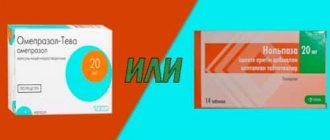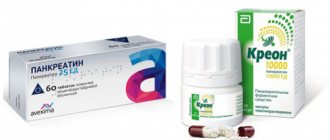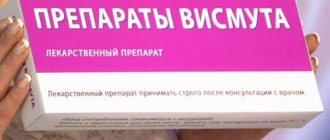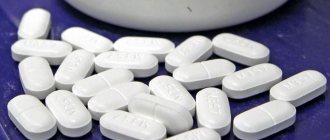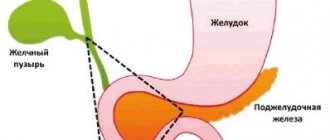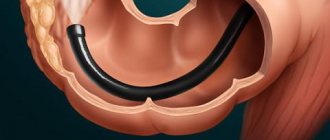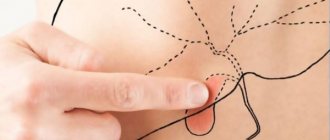De-Nol's testimony
De-Nol analogues are used for the treatment of identical pathologies, which look like this:
- ulcerative lesions that occur on the surface of the intestinal and gastric mucosa (including inflammatory processes caused by Helicobacter pylori);
- gastritis, acute gastroduodenitis, including those caused by exposure to Helicobacter pylori.
Let's look at domestic analogues of De-Nol, which include:
- Vikair;
- Novobismol;
- Escape.
Therapeutic effect
Vikair has a complex effect:
- Calamus acts as an antispasmodic;
- bismuth compounds have an astringent, gastroprotective and antimicrobial effect (against H. Pylori);
- sodium bicarbonate and magnesium carbonate are involved in the regulation of the buffering properties of gastric juice and have an astringent effect;
- Buckthorn has a mild laxative effect.
De-Nol also works comprehensively, but the breadth of its action lies in the presence of bismuth salts:
- stimulates mukocytes in the stomach, and enhances the release of PG E2;
- improves the functioning of the microvasculature of the antrum of the duodenum, promotes the appearance of epithelial growth factor in the area of ulceration and erosion;
- disrupts membrane permeability and enzymatic processes in H. Pylori cells, which suppresses their movement and reproduction;
- forms a protective film of insoluble salts on the surface of the mucosal defect.
Vikair
The active component of this analogue of De-Nol is bismuth nitrate. Its formula also includes magnesium carbonate, sodium bicarbonate, buckthorn (bark) and calamus (rhizome).
Vikair is a complex of substances that exhibits astringent and antacid effects . Bismuth nitrate promotes the formation of a layer that protects the surface of the mucous membranes and relieves inflammation, and also helps speed up regeneration. Derivatives of magnesium and sodium lower the acid level of food juice, and calamus and buckthorn are mild laxatives.
This analogue of De-Nol is produced in tablet form and its application regimen looks like this: the analogue drug should be taken 60 - 90 minutes before eating, 1 to 2 tablets three times a day. The medicine must be crushed and diluted with 1/4 cup of boiled water. The duration of therapy is 30 - 60 days. It is possible to prescribe a repeat course after a break.
Vikair is produced pharmacologically in Russia.
Novobismol
The main active component of this analogue of De-Nol is bismuth tripotassium dicitrate, which has antiulcer and gastroprotective properties . By forming a special film on the mucous membrane of the digestive tract, the drug protects damaged areas from the effects of dietary juice, thereby allowing them to quickly regenerate. This De-Nol substitute promotes the accumulation of a protein that stimulates cell growth and accelerates the regeneration of the affected area, and also inhibits the activity of pepsin and pepsinogen.
The analogue medicine should be taken orally 30 minutes before meals.
For patients over 12 years of age, 1 tablet is prescribed four times a day.
Children from 8 to 12 years old should take 1 tablet twice a day.
For young patients from 4 to 8 years old, the dosage is calculated based on 8 mg per kilogram of weight. This amount should be divided into two doses.
The duration of the therapeutic course with the De-Nol analogue is from 4 to 8 weeks.
Novobismol is produced by pharmacological and Pharmproject in Russia.
De-Nol instructions for use, side effects, domestic analogs, reviews from doctors
Among gastrointestinal diseases, the most common ailment is gastritis and ulcerative lesions of the mucous membranes of the stomach and duodenum. Treatment of these pathological conditions should be carried out in combination.
The patient is recommended to go on a diet and, of course, is prescribed medications. One of the most popular remedies is De-Nol. Let's figure out what recommendations for taking De-Nol are given in the instructions for use, what contraindications there are and what side effects may arise during the treatment process.
Description of the product
The main active component is bismuth tripotassium dicitrart. Each tablet contains 304.6 mg. It is this that determines the therapeutic effect of De-Nol: the drug has an enveloping, anti-inflammatory and astringent effect. While taking the medicine, the integrity of the damaged mucosa is restored.
Available in the form of white tablets with a slight cream tint. May have a slight ammonia odor. The tablets are packaged in blisters made of aluminum foil. One package contains 56 or 112 pieces.
Indications for use
The use of "De-Nol" will be justified in the treatment regimen for the following gastrointestinal pathologies:
- ulcers of the stomach and duodenum;
- dyspeptic syndrome;
- irritable bowel syndrome;
- gastritis – the drug is also used for chronic damage to the gastric mucosa;
- Ellison-Zollinger syndrome.
The drug can also be used in the treatment of functional dyspepsia not associated with organic lesions of the gastrointestinal tract
Pharmacological effect
It is important for the patient to understand how the drug used for treatment works. De-Nol (or De-Nol, if the name is indicated in Latin in the recipe) is a drug used in the treatment of diseases of the stomach and duodenum. The action of the drug De-Nol is complex; it is a means of:
- antibacterial;
- antiulcer;
- gastroprotective.
Advice! Despite the fact that the product helps fight infection, De-Nol is not an antibiotic. In the Pharmacological Reference Book, the medicine is included in the section “andacids and adsorbents”.
But, nevertheless, the antibacterial effect of De-Nol has been confirmed by clinical trials. The mechanism of action of the medicine is as follows: complex bismuth salt has a detrimental effect on Helicobacter pylori.
The active substance inhibits the enzyme system of microorganisms. As a result, bacteria lose the ability to move and can no longer damage the walls of the digestive organs.
Advice! An important advantage of De-Nol is that pathogenic microorganisms cannot develop resistance to the action of bismuth salts.
In addition, De-Nol has the following effects:
- binds bile acids;
- enhances the protective properties of the gastric mucosa, as it stimulates the production of mucus, which provides natural protection to the stomach;
- reduces the degree of negative effects of excess hydrochloric acid;
- helps improve blood circulation, due to which metabolic processes accelerate and tissue healing occurs faster;
- the synthesis of the enzyme peptin, which causes irritation of the mucous membrane, is reduced;
- A protective film is formed over the affected areas, which prevents further irritation and growth of erosions.
Domestic substitutes
All De-Nol analogues are highly effective and have similar indications for use. In this case, the choice of drug must be agreed with the attending physician.
Vikair
This is a complex medication with a multi-faceted effect:
- antacid;
- antiseptic;
- antispasmodic;
- laxative.
The drug is available in pink tablets. It contains a combination of active ingredients - extracts from calamus root and bismuth nitrate. It has the ability to influence the nerve endings of the gastrointestinal tract, while improving digestion and metabolism.
Prescribed orally, one tablet three times a day after meals. The course of treatment lasts at least 3 months. Vikair is indicated for diseases of the digestive system of various etiologies, such as;
- stomach ulcer and duodenitis;
- bloating;
- dyspeptic disorders;
- gastritis.
It should be used with caution with other drugs containing bismuth, since in this case its concentration in the blood increases and the risk of developing encephalopathy increases. A peculiarity of using Vikair is the appearance of black stool after taking it, and increased frequency of stools.
Pregnancy and lactation are a direct contraindication for use.
Novobismol
The medication belongs to the group of intestinal antiseptic and astringent agents. Release form: tablets. The main active component is bismuth tripotassium dicitrate, which protects the mucous membrane of the digestive tract from destruction, maintaining its integrity. It has a pronounced bactericidal and anti-Helicobacter effect.
Features of the drug use
In the presence of erosions and ulcers, it forms films on their surface. In pediatric practice, it is indicated for children from 8 years of age. Prescribed 2 tablets twice a day. Contraindicated during pregnancy and breastfeeding. Compatible with most medications.
Ranitidine
The most famous medication from the group of H2-histamine receptor blockers.
The mechanism of its action is based on the regulation of the production of hydrochloric acid in the stomach, as a result of which favorable conditions are created for the healing of ulcers and erosions.
It is available not only in tablet form, but also in injection form. The main active ingredient is ranitidine hydrochloride. Taken in an average daily dose of 300 mg - 1 tablet 2 times a day.
Injections are prescribed in extremely severe conditions. Main indications: peptic ulcer and erosive gastritis. A contraindication to the use of Ranitidine is cancer.
Source: https://sakhbmc.ru/drugoe/de-nol-otzyvy.html
Escape
Escape contains the same active ingredient as Novobismol - tripotassium bismuth dicitrate. The medicine exhibits properties that are common to all drugs included in the group of De-Nol analogues. Escape forms a film on the mucous membranes of the digestive tract, protecting the damaged surface and allowing it to regenerate as quickly as possible.
This analogue of De-Nol should be taken orally, 30 minutes before meals, and washed down with boiled water. Like all medications containing bismuth, Escape is not recommended to be taken at the same time as other medications, as well as dairy products, as this will complicate the process of absorption of the active substance from the digestive tract.
If the doctor prescribed Escape instead of De-Nol, then the dosage for patients over 12 years of age is 1 tablet four times a day, or 2 tablets twice a day.
For children from 8 to 12 years old, take one tablet 2 times a day.
For children from 4 to 8 years old, the amount of medication is 8 mg per kg of weight daily.
The duration of therapy is from 4 to 8 weeks.
This Russian analogue of De-Nol is produced pharmacologically.
Imported substitutes for De-Nol:
- Ulcavis;
- Venter;
- Ventrisol;
- Vikalin.
Novobismol or De-Nol - which is better?
Manufacturer: FP Obolenskoye, Russia
Release form: tablets
Active ingredient: Bismuth tripotassium dicitrate
Synonyms: Ulcavis, De-Nol, Escape, Vitridinol, Vikanol Life
Novobismol is also an equivalent and analog cheaper than De-Nol, it is made from a German or Chinese substance, reviews of the drug are positive, indicating the high effectiveness of the drug.
Like other Russian analogues of De-Nol, Novobismol is much cheaper.
Ulcavis and 5. Ventrisol
Some of the cheapest analogues in pharmacies are Ulcavis and Ventrisol . Both medical products include in their formula an active component - a bismuth derivative, which helps create a film of protection on the surface of the mucosa. Thanks to the use of the medicine, rapid regeneration of ulcerative and erosive lesions occurs.
The dosage of these two De-nol analogues exactly repeats the Escape treatment regimen described above.
Ulcavis is produced in Slovenia.
The manufacturer of Ventrisol is pharmaceutical in Poland.
Venter
The main active ingredient of this analogue of De-Nol is Sucralfate, which contains sucrose sulfate and aluminum hydroxide. When interacting with acids in the stomach, this component is converted into a viscous substance that envelops the mucous membranes and prevents damage to already injured areas. Thanks to the effects of Sucralfate, erosive and ulcerative lesions are scarred and heal much faster.
The De-Nol analogue is available in the form of granules, which are recommended to be taken 30 - 60 minutes before meals. The sachet of medicine should be dissolved in half a glass of boiled water and drunk.
For therapy, one packet of granules is usually prescribed four times a day. An alternative is to take two sachets twice a day.
For children over 4 years of age, the drug is allowed to be used in a dosage of 0.5 to 1 g 4 times a day.
This analogue of De-Nol is produced pharmacologically in Slovenia.
Forms of release, structural analogues, prices
De-Nol is available in tablet form in blisters of 8 pieces. The concentration of the active substance corresponds to 120 mg of bismuth oxide. The price of the drug in Russian pharmacies ranges from 544 rubles for a package of 56 tablets to 990 rubles for 112 tablets.
Complete analogues of De-Nol according to the active substance:
- Vis-nol.
- Gastronorm.
The given list is indicative. The choice of drug should be made by the attending physician in accordance with the nature of the disease.
See also:
What does Doxy-Hem and its analogues treat?
Ranitidine
An antiulcer agent, the action of which is based on reducing the formation of hydrochloric acid and secreted gastric juice. The main and additional components of the drug are ranitidine, cellactose, colloidal silicon dioxide, hypromellose, tropeolin dye. Belongs to the group of antihistamines. The mechanism of action is manifested in blocking H2 receptors and reducing basal hydrochloric acid and stimulating its secretion.
It can act as a cheap analogue of De-Nol for the relief and prevention of recurrence of gastrointestinal ulcers not caused by Helicobacter pylori.
Pharmacokinetics of Ranitidine
Indications for the use of Ranitidine:
- erosive and reflux esophagitis;
- Zollinger-Ellison syndrome;
- prevention of stress and postoperative gastric ulcers, relapses of gastric bleeding;
- prevention of gastric acid reflux during surgery under anesthesia.
For the treatment of exacerbations of gastrointestinal and duodenal ulcers, GERD, Zollinger-Ellison syndrome, 300 mg per day is prescribed orally, divided into several doses or once before bedtime. With a complex course of the disease, an increase to 600 mg per day is possible, for gastroesophageal reflux disease up to 1.2 g / day, Zollinger-Ellison syndrome - 6 g per day.
To prevent, in particular, the development of Mendelssohn's syndrome, up to 150 mg per day is prescribed. The duration of the course is 1-2 months. Patients with a history of kidney disease are treated at a dosage of 150 mg/day.
It is not recommended to use Ranitidine in case of hypersensitivity, pregnancy and breastfeeding, and children under 14 years of age. Only in case of urgent need is it prescribed for pathologies of the kidneys and liver, portosystemic encephalopathy and acute porphyria.
Treatment with Ranitidine may be accompanied by:
- signs of poisoning, dry mouth;
- development of hepatitis, acute pancreatitis;
- decrease in the number of leukocytes, platelets;
- increased levels of prolactin, creatinine, GGTP;
- development of bone marrow failure syndrome, replacement of its myeloid tissue with adipose tissue;
- hemolytic anemia;
- hypotension, decreased or increased heart rate, ventricular arrhythmia, vasculitis;
- fatigue, sleep disturbance, headache, dizziness, emotional instability, depression, increased body temperature, clouding of consciousness, tinnitus, hallucinations, hyperkinesis, convulsions;
- deterioration in vision clarity, accommodation paresis;
- muscle-joint pain;
- enlarged mammary glands, amenorrhea, decreased libido;
- allergies (including Stevens-Johnson syndrome);
- baldness, acute porphyria.
The main difference between Ranitidine and De-Nol is the lack of antibacterial action against Helicobacter pylori.
Omeprazole
A medicine that belongs to the group of antiulcer drugs. The active ingredients of the medicine are omeprazole and pellets. The mechanism of action of the drug is based on reducing the secretion of gastric juice and reducing its acidity. Together with antibiotics, it promotes the eradication of H. pylori, accelerates the healing of the mucosa and prevents exacerbations of the disease and the risk of gastric bleeding.
Recommended for relief and prevention of:
- stomach ulcer;
- benign and peptic ulcers of the gastrointestinal tract, as well as those caused by taking NSAIDs;
- reflux esophagitis;
- Zollinger-Ellison syndrome.
pharmachologic effect
Classical therapy consists of taking 20 mg of Omeprazole orally once a day in the morning on an empty stomach. In situations of severe or recurrent disease, the dose is increased to 40 mg. The duration of therapy is 1 month. In the absence of complete regeneration of damage, the drug intake can be increased to 2 months.
It is not recommended to take it if you are sensitive to the components of the drug, or in combination with Nelfinavir or Atazanovir. The limit is children under 1 year of age.
The increase in negative effects does not depend on the dose and can be expressed:
- in a decrease in the level of leukocytes, platelets, calcium, magnesium or all blood components;
- blurred vision;
- headache, dizziness, numbness of the extremities, decreased perception of taste, drowsiness, insomnia, hallucinations, emotional lability, slowness of thinking, malaise, increased sweating;
- allergies, alopecia, Stevens-Johnson syndrome, Lyell syndrome, erythema multiforme, photosensitivity;
- symptoms of poisoning;
- stomatitis, candidiasis, dry mouth;
- hepatic encephalopathy, hepatitis C, jaundice, increased levels of AST and ALT;
- joint and muscle pain and weakness;
- interstitial nephritis, edema;
- enlargement of the mammary glands.
The main difference between the drug and De-Nol is the need for additional use of antibiotics against H. pylori.
Vikair
The closest analogue of De-Nol, but cheaper, which belongs to the group of drugs for the treatment of peptic ulcers and gastroesophageal reflux disease. The active ingredient of the drug is also the equivalent of bismuth oxide - bismuth nitrate. Vikair has an antispasmodic and astringent effect.
Buckthorn bark, which is part of the drug, has a laxative effect, which facilitates the use of the drug for the treatment of non-neurogenic or endocrine constipation.
Vikair is prescribed for the treatment of:
- ulcers of the gastrointestinal tract and duodenum;
- antacid gastritis;
- functional dyspepsia.
Vikair and Vikalin
In order to improve absorption, it is advisable to crush the tablets before use. The daily dosage is 1-2 tablets an hour after meals. The duration of therapy lasts no more than 2 months.
You should not treat with medication if:
- allergies to Vikair components;
- gastritis with low acidity;
- stomach bleeding;
- elevated body temperature;
- appendicitis and other diseases characterized by symptoms of acute abdomen;
- acute and chronic inflammation of the intestines and gall bladder.
Taking this medication may cause:
- nausea, vomiting, increased frequency of bowel movements, coating on the tongue;
- headache;
- increased hemoglobin levels;
- swelling of the gums and eyes;
- allergies.
Unlike De-Nol, Vikair has fewer side effects. The medicine contains natural ingredients, which makes it better tolerable. The drug also has an analgesic effect and minimizes spasms of the smooth muscles of the gastrointestinal tract.
See also:
List of the cheapest substitutes for Heptral®: TOP 5 analogues of the drug
Phosphalugel
A drug that belongs to the group of antacids. It is used to minimize the activity of pepsin, coats the walls of the stomach, normalizes its acidity without the effect of alkalization. It also has adsorbing properties. The active substance is aluminum phosphate.
Phosphalugel is successfully used in the treatment of:
- hyperacid gastritis;
- diaphragm hernia;
- syndrome of functional dyspepsia and diarrhea;
- intoxication;
- gastroesophageal reflux;
- to minimize the negative impact of substances that irritate the gastrointestinal tract.
Properties of Phosphalugel
Phosphalugel powder is consumed dry or diluted with water 2 hours before meals. To relieve a diaphragmatic hernia, drink immediately after meals and at night. For the treatment of functional pathologies of the colon, the drug should be taken in the morning before meals and before bed.
For people over 6 years of age, 1-2 sachets are prescribed 2-3 times a day. Children under 6 months are given 1/4 sachet 6 times a day after feeding, from 6 months the dose increases to half a sachet 4 times a day after meals. Under the supervision of a doctor, Phosphalugel is prescribed for kidney disease, cirrhosis, and decompensated myocardial dysfunction.
Phosphalugel is easily tolerated and can be prescribed during pregnancy and infancy. Does not have the property of eradicating Helicobacter pylori. The negative consequences of treatment with the drug manifest themselves in the form of constipation.
Venter
The medication, due to its active substance sucralfate, envelops the walls of the stomach and minimizes the aggressive effects of hydrochloric acid and bile salts. The product activates the regeneration of damage, healing of ulcers, prevents relapses of the disease, and reduces the effect of pepsin by 30%.
Venter is used in therapy:
- stress, drug-induced and symptomatic ulcers;
- stomach erosions;
- hyperacid gastritis;
- gastroduodenitis;
- reflux gastritis and esophagitis;
- hyperphosphatemia;
- heartburn.
Description of the drug
The treatment regimen is determined by the doctor in accordance with the specifics of the pathological process and the age of the patient. Most often, it is recommended to take 1-2 g 2 times a day in the morning on an empty stomach and before bed. Children are prescribed half the dose of 0.5 g with a dosage frequency of 4 times a day. The maximum daily dose is 12 g. Duration of administration is 1-1.5 months. In severe cases, it can be extended up to 3 months.
It is not recommended to treat patients under 4 years of age, with stage 3-5 CKD, gastric bleeding, impaired transit of intestinal contents through the digestive tube, dysphagia, and allergies to Venter components.
Should be used with caution during pregnancy.
During treatment, adverse reactions may occur:
- change in stool;
- nausea;
- dry mouth;
- cramping abdominal pain;
- sleepy state;
- dizziness;
- headache;
- allergy;
- pain in the lumbar region.
Venter is relatively easily tolerated by patients. The drug has a binding effect, helps reduce the effect of pepsin, however, it is not effective against Helicobacter pylori.
Ulgastran
Antiulcer antacid medication belonging to the group of gastroprotectors. Envelops the gastric mucosa, reduces the production of pepsin and bile. The active component of Ulgastran - sucralfate - accelerates the healing processes of the gastric and duodenal mucosa.
It is advisable to use Ulgastran in the treatment of:
- ulcers of the gastrointestinal tract and duodenum;
- inflammation of the gastric mucosa;
- preventing the formation of ulcers;
- reflux gastritis and esophagitis.
The drug is taken 4 times a day before meals and at night, 1 g. Not recommended for children under 4 years of age, with CKD stages 3-5, dialysis, reduced concentration of phosphates in the blood, hypersensitivity to the components of the drug, during pregnancy.
During therapy the following may be observed:
- dizziness;
- headache;
- sleepy state;
- change in stool;
- abdominal cramps, heartburn and bloating;
- nausea and vomiting.
Ulgastran is indicated for the symptomatic relief of symptoms of peptic ulcer and gastritis. Treatment of gastrointestinal damage caused by Helicobacter pylori should be carried out in combination with antibiotics.
See also:
List of inexpensive substitutes for Grammidin®: TOP 6 analogues
Vikalin
Vikalin is an analogue of De-Nol and is often prescribed to replace it.
The main components of this complex product are:
- bismuth subnitrate;
- magnesium carbonate;
- potassium bicarbonate;
- buckthorn bark;
- calamus rhizomes;
- Kellyn;
- routine
Bismuth subnitrate (similar to colloidal bismuth subcitrate in De-Nol) envelops the inner surface of the digestive organs with a protective layer and helps relieve inflammatory processes, as well as rapid healing of damage.
Magnesium carbonate and sodium bicarbonate reduce the acidity of food juice and prevent the action of digestive enzymes.
Kellin and calamus are antispasmodics.
Buckthorn is a mild laxative.
Vikalin tablets are crushed and mixed with a quarter glass of boiled water. The medication must be taken orally, after eating food, 1 - 2 tablets three times a day.
The duration of therapy with this De-Nol analogue is from four to 8 weeks.
A repeat course may be prescribed after a break and examination by the attending physician.
Gaviscon
A wide range of drugs, united under the name Gaviscon, is used for the treatment of obvious and erosive damage to the digestive tract, and can act as an analogue of De-Nol.
The main active ingredients of Gaviscon double action are sodium alginate, sodium bicarbonate and calcium carbonate.
Calcium carbonate and sodium bicarbonate help neutralize the acid level of gastric juice and help quickly reduce the negative manifestations of ulcers (heartburn and digestive disorders). Sodium alginate envelops the mucous membranes of the gastrointestinal tract, preventing injury to already affected areas.
Drugs from the Gaviscon series are analogues of the drug De-Nol and are prescribed to replace it in case of side effects or contraindications to the main drug.
For patients over 12 years of age, 10 to 20 mg (2 to 4 teaspoons) of the drug is prescribed, 2 to 4 times a day. The suspension should be shaken thoroughly before use.
The entire list of Gaviscon medicines is produced pharmacologically in the UK.
De-Nol analogues: cheap substitutes for tablets
In the treatment of diseases of the digestive system, gastroprotectors are often used - drugs that are aimed at restoring damage that occurs during the development of diseases.
The most famous gastroprotector option is De-Nol. The drug is produced in the Netherlands. It is quite effective, but not cheap, so many patients are interested in whether De-Nol has analogues sold at more affordable prices.
Description of the drug De-Nol
As already noted, De-Nol and its analogs belong to the category of gastroprotectors. These drugs are used to treat chronic forms of gastritis, gastric and duodenal ulcers, irritable bowel syndrome, as well as functional digestive disorders not associated with organic damage to organs. The product has the following effects:
- protects the gastric mucosa, forming a dense film over areas of damage to the mucosa. Thanks to this, damage is restored faster;
- has an antimicrobial effect against Helicobacter pylori bacteria, which are the main cause of gastritis and ulcers;
- improves blood circulation in the digestive organs, which improves tissue nutrition. And improved trophism leads to faster recovery of damage;
- has an anti-inflammatory effect, relieves pain, nausea, heartburn and other unpleasant symptoms.
Features of use
Before starting therapy with any of De-Nol's analogs, you must make sure that the patient has no contraindications to the medicine. Otherwise, therapy may give a negative result and cause serious consequences. Bismuth derivatives, when the therapeutic dose is exceeded, can cause manifestations of renal failure requiring special treatment. That is why, if the De-Nol analogue contains bismuth, violations of the functional activity of the kidneys will be contraindications for its use.
